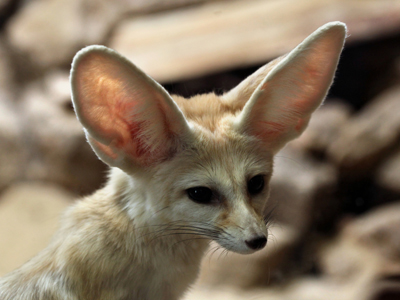
Ask the AI Tutor
Need help with Physics - Rate of Heat Transfer (AQA)? Ask our AI Tutor!
AI Tutor - Lucy
Connecting with Tutor...
Please wait while we establish connection

The fennec fox has very large ears which help it to keep cool.
Physics - Rate of Heat Transfer (AQA)
Explore how temperature difference, surface area and insulation affect the rate of heat transfer in everyday situations, from hot drinks cooling to radiators warming a room.
1 .
Which of the features of a vacuum flask is designed to slow down the rate of heat transfer by reducing both conduction and convection?
The vacuum
Cork base
The lid
Silvering the side walls
The cork base will reduce heat loss by conduction whilst the lid reduces heat loss by convection but the vacuum minimises both at the same time
2 .
The smallest fox in the world, the fennec fox, lives in the Sahara desert. It has very large ears. How do its ears help it to keep cool?
They can be flapped backwards and forwards creating a cool breeze over the fox
The fox can twist and bend its ears to shade itself from the Sun
They have a large surface area
They don't help at all
This is testing your knowledge of how surface area and volume affect the rate of heat transfer. Since the ears have a large surface area compared to their volume, they will lose thermal energy quickly
3 .
LEDs are low energy alternatives to conventional light bulbs but they still generate a lot of heat when they are switched on. They need to be attached to a heat sink to keep them cool. Which of the following would make a good heat sink for an LED?
A solid block of plastic
A solid block of metal
A block of polystyrene foam
A metal plate with fins
A metal plate with fins is a heat conductor which has a large surface area with a low volume. This makes it efficient at transferring heat from the LED into its surroundings - the air
4 .
18,000 J of energy was transferred from an electric heater to a 2kg block of steel. The temperature increased by 18oC. Based on these figures, what is the specific heat capacity of the steel?
500 J/kg
3,600 J/kgoC
500 J/kgoC
3,600 W/kg
You need to rearrange the equation to isolate the specific heat capacity. It is unlikely that you would be asked to give the correct units in an exam but it is worthwhile knowing them, just in case you are.
5 .
Which way does thermal energy travel?
From hotter to cooler
From cooler to hotter
From a conductor of heat to a non conductor
It varies depending on the situation
Thermal energy always spreads out into the cooler parts of the environment around the hotter area
6 .
If 18,000 J of energy was transferred from an electric heater over the course of 2 minutes, what is the rate that heat was transferred?
150 J/s
150 W/s
9,000 J/s
9,000 W/s
This actually gives you the power rating of the heater - 1 joule per second is 1 watt so a 150 watt heater was used
7 .
Which of the following features of a vacuum flask is designed to reduce the rate of heat transfer by radiation?
The vacuum
Cork base
The lid
Silvering the side walls
Smooth shiny surfaces reflect infrared (thermal) radiation the best
8 .
A cool box is used to keep food cooler than the surroundings. They are often used to carry chilled or frozen food home from a supermarket or to keep food fresh at a picnic. Which of the following materials would be suitable to make the walls of a cool box?
Aluminium alloy
Thin plastic
Thick plastic
Polyurethane foam (a type of plastic that contains air bubbles)
It's light and has a low U-value
9 .
Which of the following would be the worst conductor of heat?
Copper
Wood
Aluminium
Brass
Materials not made from metals are poor heat conductors
10 .
A group of students carried out an investigation into the rate at which different foods cool down. They measured the temperature of each food at 30 second intervals until the food had cooled from 80oC to room temperature. They then drew graphs of the results. In each case, the graph was the same shape. Which of the following describes the shape of their graphs?
A linear graph with a negative gradient
A lineear graph with a positive gradient
A curved line graph with a negative gradient that is steeper at higher temperatures
A curved line graph with a positive gradient that was steeper at lower temperatures
The bigger the temperature difference between an object and its surroundings, the faster heat is transferred, so the food cooled down faster (steep negative gradient) at hotter temperatures
**Unlimited Quizzes Await You! 🚀**
Hey there, quiz champ! 🌟 You've already tackled today's free questions.
Ready for more?
Ready for more?
🔓 Unlock UNLIMITED Quizzes and challenge yourself every day. But that's
not all...
not all...
🔥 As a Subscriber you can join our thrilling "Daily Streak" against other
quizzers. Try to win a coveted spot on our Hall of Fame Page.
quizzers. Try to win a coveted spot on our Hall of Fame Page.
Don't miss out! Join us now and keep the fun rolling. 🎉
**Unlimited Quizzes Await You! 🚀**
Hey there, quiz champ! 🌟 You've already tackled today's free questions. Ready for more?
🔓 Unlock UNLIMITED Quizzes and challenge yourself every day. But that's not all...
🔥 As a Subscriber you can join our thrilling "Daily Streak" against other quizzers. Try to win a coveted spot on our Hall of Fame Page.
Don't miss out! Join us now and keep the fun rolling. 🎉






